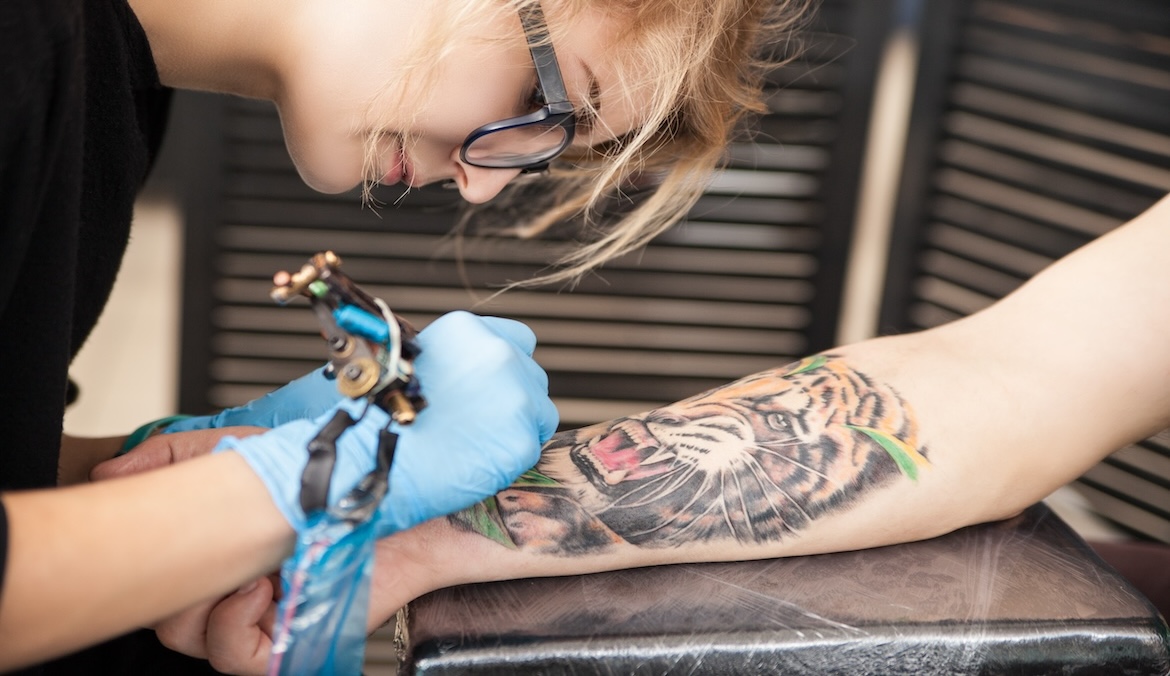New research from the U.S. Food and Drug Administration (FDA) shows that sealed bottles of tattoo and permanent makeup ink can contain millions of potentially dangerous bacteria—even those bottles that have been labeled “sterile.”
If you’ve gotten a tattoo or permanent makeup recently, or are planning to, that’s a rightfully concerning thing to read. So should this new study make you rethink getting inked?
“The presence of bacteria in tattoo and permanent makeup ink is indeed a cause for concern,” board-certified plastic surgeon Joel Kopelman, MD, FACS, tells Well+Good. “When these inks are contaminated, they pose a significant risk of infection to consumers.”
Those in the tattoo industry concur.
“This contamination poses significant health risks,” Selina Medina, director of research for the Alliance of Professional Tattooists (APT), which works to promote tattoo safety, said in a statement to Well+Good. “However, it’s important to recognize that bacteria are present in many products we use daily, including food, medical devices, and cosmetics. While this can be concerning, there are steps both artists and consumers can take to mitigate these risks.”
It’s true that bacteria is present around some other commonly-used products. But it can be more dangerous in the case of tattoos and permanent makeup, which involve piercing the skin and therefore making it easier for bacteria to enter the body, notes Dr. Kopelman, who regularly treats patients who have gotten tattoos and permanent makeup.
How to protect yourself when getting a tattoo
Bacteria can get into tattoo ink at the manufacturing stage if it’s not handled or tested properly, or even after it’s arrived at a tattoo shop if it isn’t stored properly, experts say. (Proper storage includes keeping the ink in a cool, dry place away from direct sunlight and with the lid tightly screwed on the bottle.)
Tattoo ink is treated as a cosmetic—meaning it’s not subject to the same oversight as prescriptions or even over-the-counter medications. With that in mind, manufacturer contaminations happen in part because there aren’t many standards—the FDA offers guidance steps in when safety issues are reported, but as with other cosmetics, tattoo ink doesn’t need FDA approval to be sold.
Across the industry, the APT says they’re working with regulators including FDA to make sure manufacturers and tattoo artists are adhering to safety protocols. Experts also say it’s important for those getting tattoos to ask questions and make sure that the artist is following necessary health and safety precautions.
“While the study highlights a serious concern, consumers can take steps to protect themselves,” Dr. Kopelman says.
These are the biggest safety tips experts say you should follow before and after getting a tattoo to mitigate your risk.
Choose a reputable artist with strict hygiene practices.
Your artists should be purchasing tattoo ink from reputable manufacturers who follow strict quality control standards, the APT says. Artists should also take proper care of ink, including ensuring that cross-contamination doesn’t occur during the tattoo process. That means switching gloves between distributing the ink from the bottle to the tray and touching the client’s skin.
While the APT doesn’t offer a list of specific brands or suppliers that best meet standards, it suggests sticking to ink suppliers that implement “third-party testing and a certification to confirm the absence of contaminants.”
“Sterility of the inks used is paramount,” Dr. Kopelman says. “This includes using inks from trusted suppliers that guarantee sterile products.”
Follow aftercare instructions.
Your tattoo artist should provide you with a list of aftercare instructions—both to keep the tattoo looking the way it should and to protect yourself from getting an infection.
Best practices usually involve keeping a bandage on for three to five hours, washing the tattooed skin, gently patting it dry, applying a thin layer of ointment (such as Vaseline or Aquaphor), and repeating the process three to four times a day for four days, per Harvard Health. You should also avoid picking or scratching at shedding skin, and keep the tattoo out of the sun, pool and beach for the first few weeks.
Know the signs of an infection.
An infection can occur directly after getting a tattoo, or even in the days or months post-ink, according to the American Academy of Dermatology Association (AAD). While some redness and swelling is normal, something may be wrong if the redness darkens and spreads, pain worsens, pus or open sores develop, or if you experience chills or fever.
“Keeping the treated area clean and following the artist’s aftercare instructions can help minimize the risk of infection,” Dr. Kopelman says. “If any signs of infection appear… it’s important to seek medical attention promptly.”
Well+Good articles reference scientific, reliable, recent, robust studies to back up the information we share. You can trust us along your wellness journey.
-
Yoon S, Kondakala S, Foley SL, Moon MS, Huang MJ, Periz G, Zang J, Katz LM, Kim S, Kweon O.0.Detection of anaerobic and aerobic bacteria from commercial tattoo and permanent makeup inks. Appl Environ Microbiol0:e00276-24.https://doi.org/10.1128/aem.00276-24
